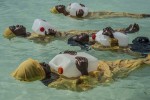This post was updated Jan. 11 at 5:02 p.m.
Swimming has become an empowering activity for young women in Zanzibar.
Photos of them learning to swim, an activity unprecedented for women in Zanzibar, are the subject of alumna Anna Boyiazis’ series “Finding Freedom in the Water.” Boyiazis will discuss her project Saturday at the Fowler Museum at UCLA.
When she first came to Zanzibar, Boyiazis said she was told that girls were generally discouraged from the activity and, thus, never learned how to swim. Zanzibar’s Muslim community maintains certain societal restrictions on the clothing women can wear, meaning many women’s swimsuits are taboo. Zanzibari women are also generally expected to dedicate themselves solely to household and domestic duties, Boyiazis said, preventing them from pursuing outdoor activities such as swimming. A friend later informed her that more girls had started learning how to swim through The Panje Project, a Zanzibari nongovernmental organization, motivating Boyiazis to travel to Zanzibar and document the changes to the lives of women there. With her series, Boyiazis said she hopes to discuss how the photos demonstrate the empowering step for the Zanzibari women as they defy cultural expectations through swimming.
“Once the idea (of photographing the Zanzibari women) was planted and blossomed, that was the perfect time for my interest in human rights, public health, and women and girls’ issues,” Boyiazis said.
“Finding Freedom in the Water” documents the first steps toward changing gender expectations in Zanzibar, she said. During her six months on the island, Boyiazis said she meticulously observed Zanzibari customs to gain the trust and respect of the community, donning full-length garments that covered her arms and sometimes her head when photographing the budding swimmers. Born to a family of Aegean islanders in California, Boyiazis always possessed a love for swimming. Her love for the water motivated her persistence through the obstacles she faced when photographing the Zanzibari women, she said.
Without the aid of a translator to talk with the women and girls in Zanzibar, Boyiazis could only use photography to portray their stories. As she photographed the Zanzibari women, Boyiazis said she intently focused on shape and emotion in her photography, while wading through waist- to chest-deep waters. In one photo, a young woman floats in the water in a black, full-length abaya with a calm expression on her face, demonstrating her familiarity with the water.
Fabian Knierim is a curator for the WestLicht museum in Vienna, where “Finding Freedom in the Water” was displayed for a the 2018 World Press Photo Vienna Exhibition as part of the annual photo award. He said the series depicts a hidden yet powerful story – something that’s less likely to make a major news headline. The basic tools the women needed to swim, such as full-length swimsuits and plastic canisters to float, aim to move audiences by evoking a sense of hope. The simplicity of the activity proves how little is needed to create meaningful changes, he said.
Boyiazis’ efforts to photograph the event have not gone unnoticed, with “Finding Freedom in the Water” being displayed at various photo exhibitions. Sophie Boshouwers, a curator and exhibitions manager at the World Press Photo Foundation, said the photos’ vibrant colors of the ocean and Boyiazis’ proximity to her subjects are what make “Finding Freedom in the Water” stand out. Though she said news stories detailing problems in the world are necessary, Boshouwers said people also need to see stories about solutions, such as those captured by Boyiazis.
“As opposed to bringing you only the negative side of the story, (Boyiazis) paints a complete picture,” Boshouwers said. “And she actually shows people around the globe a more complete picture of the world.”
One photo from the series displays four young women floating in the water, each holding onto a large plastic canister for buoyancy. From afar, some audiences at the World Press Photo exhibitions initially thought the women were drowning, Boshouwers said. They realized upon closer inspection that the photo was telling a completely different story – the women were in control and unafraid of the water. The way “Finding Freedom in the Water” can shift viewers’ perceptions and prompt them to re-evaluate how they see pictures makes the series captivating, she said.
However, “Finding Freedom in the Water” is not without controversy. In a recent Instagram takeover Boyiazis did for the World Press Photo Foundation’s account, she encountered several heated conversations regarding the women’s full-length swimsuits. She said many commenters viewed the swimsuits as representative of an oppressive culture, rather than seeing that the women learning to swim may be a small but steady step forward. Nevertheless, Boyiazis said she still hopes to share her work to help people understand Zanzibar’s culture.
“I feel that education, whether it be in or out of the water, serves as a springboard, providing women and girls the empowerment tools to claim their life and change existing barriers,” she said.
